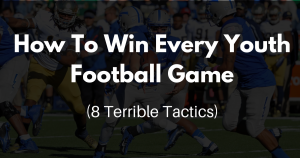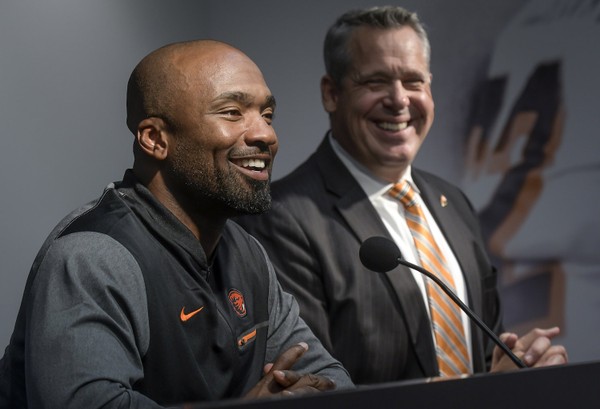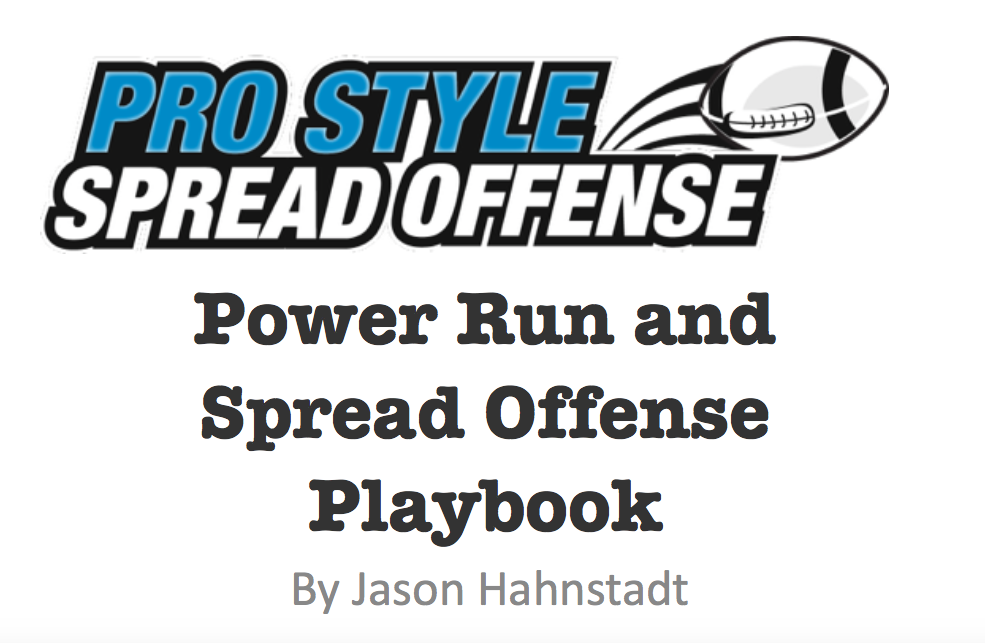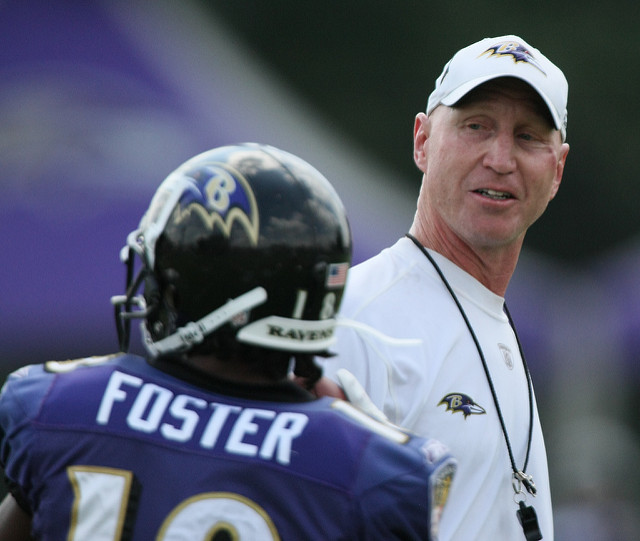
A few years back I had the opportunity to be the head football coach of a Freshman team. As a young head coach I was pretty pumped with the opportunity to mold my team into something that was going to be incredible and prove to others how great a coach I was.
That year we had a large enough team to fill all the positions on both sides of the ball with decent players. I also had an assistant coach who was able to fully take over our defensive game planning allowing me to focus solely on offense.
I had just enough knowledge at that time to make myself dangerous so early in the season I already had a good bank of plays we ran quite well. I felt we could step it up a notch and really give defenses some trouble by going hurry-up no huddle.
So we put some plays in as one word play calls and were ready to try it out on our next opponent!
Little did I know what was going to happen.
When they rolled off the bus my first thought was…oh my, they are big and there sure are a lot of them!
But boy was I wrong. In our first two possessions we scored in only 3 to 4 plays per drive.
What I didn’t know at that time was that at the younger levels of football, teams that can execute at a no huddle tempo have a huge advantage over opposing defenses.
Defenses are not at all prepared to handle that kind of up-tempo attack, especially without any kind of preparation or film study, which is pretty much guaranteed to not be possible at that level.
But did I stop? Foolishly no. We were up by almost 50 at half-time.
The entire second half was me trying to save face.
Never have I had a worse time shaking a coaches hand at the end of the game.
Because I’m not so sure this was a good thing I did.
Here’s a few reasons why it wasn’t such a good idea to deprive my developing team of young players the opportunities they needed:
• They don’t get a chance to practice blocking against a prepared defender.
• They don’t get to practice their blocking schemes because the defense never really gets lined up.
• They don’t get to experience how to stick with a series of offensive plays and drive down the field and get a rhythm going.
• They don’t get to practice a variety of play-calls all from which they can learn to execute better.
It all came down to my own EGO and wanting to win more then anything else. I stopped seeing youth football as a way to grow the game, care for players, and develop players for the future.
Terrible Tactic #1: Play Your 11 Best Players as Much as Possible
I have been guilty of this one early on in my coaching career, but especially with youth football, only playing those top 11 players and no one else is a big sign of a coach who only wants to win.
When they get to Varsity High School…I totally agree, the best players play.
But in youth football, when you have the coach who basically takes the stars and then plays them offense and defense all the way (except for a few spots on special teams), all those other players never get a chance to even begin to develop their abilities.
They might get a little chance when they have to rest up the starters who are so fatigued to the point they can’t possibly play any more.
Once they have the score run up on much weaker opponents, then they can take the “risk” of finally putting in a weaker player to rest him up a few plays until he can go back in.
What you should do differently:
Just make sure to give all your players a fair amount of time on the field to actually get experience. NOTE: I didn’t say they get to pick where they play all the time. But remember, kids notice every little thing you do and if you never share the opportunities, resentment starts building even if you don’t see it.
I will have starters and a clear rotation at each position so that every player gets an opportunity to develop when I coach the youth levels. My goal is to stick with a set rotation until the end of the game when we may need to have certain players playing to give us the best opportunity to win only at the end of the game.
Terrible Tactic #2: Run an all out blitzing attack and force the offense to be completely one dimensional.
Most youth teams don’t have the luxury of multiple Wide receivers and a gun-slinging and elite running QB.
And even fewer teams can actually block against a “kitchen sink” blitz package.
So you call the blitz every time and either their RB gets stuffed or the QB gets sacked and the fans go nuts about how great their defense is.
Only problem is actual defense has little to do with it. Defenders are not at all learning to read their keys and play with proper defensive technique!
And instead it becomes a ridiculous battle of the “Jimmies and Joes” again with one (early maturing) top athlete pitted against another just trying to outrun each other.
Because most youth players aren’t strong or accurate enough to pass the ball dropping back from the gun to all over the field, teams can cheat by playing man coverage on the perimeter and packing everyone else in the box.
Now coaches are not giving players the opportunity to practice block destruction, reading their keys, pursuing the football, playing pass coverage, learning zone passing principles, etc.
What you should do differently:
Youth football teams should as much as possible run a modern defense that balances numbers inside and outside the box like upper level teams are forced to do.
Go ahead and run the 50 defense or 4-4 or whatever they call it, but at least they need to teach proper adjustments to spread formations. You should know better then to keep all 8 guys in the box against a spread 2 x 2 or 3 x 1 formation. No defensive coordinator in their right mind can run that way against a legitimate spread team in HS ball and not get killed with screens and the quick passing game.
Plus, a secondary that only knows how to man up is depriving all those DB’s of learning from the many Zone defenses that are critical to learn and execute at the next levels of football.
If you don’t know how to run a legitimate defense, go to my good friend Joe Daniel here and learn his 4-2-5. Not only will you be a better coach for it, but your players will also be far more prepared for the next level.
Terrible Tactic #3: Go hurry-up no huddle ALL GAME LONG.
When I first started running hurry up no huddle at the lower level of football, I couldn’t stop myself from the excitement knowing that there was no way the defense could line up in time or have a prayer of a chance of stopping us from running even our base offense at full speed.
The problem with this strategy is that Hurry-up no huddle flat-out works in youth football.
And it may be causing our players to miss a critical part of development.
Youth football players are just beginning to grasp the game.
Just to stop a hurry up no huddle offense you have to know what you are doing AND get ready quickly to read the play AND get off blocks to make the tackle or cover the WRs.
With a low football IQ in the youth levels, the offense doesn’t have to worry about defenses being ready for it so they easily run the plays without needing much blocking up front.
Now there are a lot of easy scores in what amounts to a blow out which just discourages defensive players from trying to understand what is going on.
I see it now and wish I could have taken that game back. We ended up really having to try to speed up the game to save face from embarrassing the other team, which is still embarrassing because it mean putting the ball in the hands of guys who had no business ever carrying the football. (ouch and more ouch)
EDITORS NOTE: I got some criticism on this point and I do agree that playing against a worthy opponent, this can be an acceptable strategy. I even strongly advocate practicing no-huddle so that you can speed up your practice reps and get more players good reps (provided that they know what to do!)
But going Hurry-Up No Huddle in games often not a good thing for youth football development.
What you should do differently:
At least at the beginning of the game or as soon as it’s obvious they other team can’t handle it, run a base tempo and use huddling to get everybody on the same page and give defenses half a chance to line up correctly.
Now the offensive team and defensive team can work on running and passing fundamentals that are going to help them develop.
Terrible Tactic #4: Tell Your Players They Shouldn’t Play Other Sports
This one hits close to home to me for multiple reasons.
First, when you look at all the recruited football athletes in top D1 programs, a very high percentage of them played multiple sports. (Track, Baseball, Wrestling, Basketball, etc.)
So if a coach ever tells you that you need to do that, run away as fast as you can. They probably have their pocketbook in mind far more then your child or they just want to get the good athletes to commit 100% to their sport.
They think it leads to more wins and may even tell parents their child will get left behind and not be able to catch up.
Not only is this wrong, it has been proven time and time again.
I guarantee that an athlete that spends his time with a trainer in a weight room or doing off-season drills will not come close to achieving the potential he could have achieved had he joined another sport and truly dedicated himself to his development as a total athlete. Not to mention in football you have the entire summer to dedicate to getting ready for football season!
You also miss out on competition, being coached as part of a team, developing your athleticism in a complimentary way and most of all camaraderie.
What you should do differently:
Stop telling your kids to just do it because it will make them better at football. No coach in their right mind wants a player to join their team to get better at another sport. Instead, tell them to go expand their interests and find ways to compete everywhere and most of all, have fun.
Playing another sport helps them develop into a better all-around athlete.
I was a basketball junkie in H.S. but it just didn’t work out. Had I not also played football and ran track I would have never had the incredible joy of playing collegiate football and then later on now in life loving my opportunity to coach both football and track.
Terrible Tactic #5: Put the fear of God into Young Referees so That They’re Afraid To Call The Game Fairly Make Calls Against Your Team
Not only that…just look at the example you are setting!
If you didn’t know it, being a referee is not an easy job.
It’s much easier to help out a coach you are intimidated by as a referee then to call the game honestly.
In College summers, I was a baseball umpire to earn a few extra bucks. Most coaches were pretty cool but there were a few who just made the job miserable. Not only was it hard to keep calling it fair, but it made me second guess myself and I wasn’t as focused on calling the game well.
If you have to do this to get a few calls all game you’re just sinking to a level that doesn’t help the game or your players very much.
PLUS, now the players think every call should go their way and lose respect for the integrity of the game as well.
What you should do differently:
Focus on your team and set a proper example for your players to respect officials.
You are not a perfect coach and your players aren’t perfect blockers and tacklers.
Terrible Tactic #6: Just Have the Best Players Run the Ball or play close to the Line of Scrimmage.
I’ve seen plenty of coaches telling weaker players to just stay deep on defense while the better players on the team get to play up tight.
Or on offense, I’ve seen coaches tell players to just keep both hands on the ball and let them tackle you.
Players will not develop if all they get to do is jog backwards every play and never come up to attempt a tackle. Or if they never get a chance to run the ball?
What you should do differently:
Coach every player the same and try to help them make the right football play even if they are outmatched. At the very least they can force players one direction or another.
When we get a comfortable lead I make a conscious effort to get the players that don’t usually carry the ball more opportunities.
Terrible Tactic #7: Make Your Biggest, Strongest and Fastest Players Play the Key Skill Positions.
Coaches instruct these players to be only in these key roles. You want to win right?
So they get to be the ones running and throwing the ball only right? “We can’t have anybody else do it.”
So in practice all they do is run and throw and nobody else gets to do it.
Now when these “bigger” (or just early maturing) players advance to the next level and are no longer the biggest, baddest and fastest, now they get thrown into a role they have never learned or played.
Moreover, they think football is all about just them getting the ball and they usually end up not getting the complete picture about football and being selfish players.
Don’t teach some players exclusively that football is only about running and passing and catching when we all know it’s about running, blocking, and tackling. You just don’t know how they are going to grow and develop in the future.
What you should do differently:
Create multiposition players.
I made the mistake early on of locking players into certain positions and it’s one I won’t make again. From day one I talk to kids about playing multiple positions. It makes them better players all around. And sometimes I’m even surprised at the results! Who knew that kid could iso block like that? Or who knew this other one had a knack for getting off blocks!
Plus doing it from day one keeps the ego of the position out of their heads. Everybody has to learn to block and tackle. Even on the line everybody learns both sides of the ball and multiple positions. Sometimes this has saved games for me when I have to go to Center or QB #3!
Worried about the numbers on the jersey? Just bring an extra lineman or eligible # jersey to swap….if the officials are super picky about it!
Terrible Tactic #8: Tell your QB who to throw it to every time or whether to keep, give or pitch the FB.
I believe that the reason a coach should not be doing this is because you are robbing your QB from the opportunity to develop decision making skills himself.
And if he’s not ready to make those decisions yet, then you need to simplify or figure out why.
It’s just a coaching shortcut that hurts him in the long run because the QB is the coach on the field and the next guy who gets him may not be as willing to do the same.
So teach him why he should do something and then ask him why he did it that way. It may actually make more sense sometimes and now he has confidence in his own decisions.
What you should do differently:
Introduce decision making slowly and with very simple, clear rules. Also have a rule for the “grey” areas. For example…if you’re not sure…give it on option. This way you can at least avoid the drive stopping play.
My favorite youth football offense is any offense that has a good combination of running, passing, and some option.
The future of modern football today is all about making decisions in the flow of the game after the snap. That’s why football is dominated by Option and RPO’s.
Remember the Run and Shoot? It is all based on decisions after the snap.
Teach pass plays with a full progression. Teach them how to make decisions and discuss why they made the decision they did.
I am tired of seeing hotshot freshman QB’s show up who have never made a simple flat read in their playing career before and trying to reteach them to follow a progression and read green grass.
Or they think progression is a joke because all they look for is the guy they think gives them the least chance to get intercepted.
Conclusion
So if you’ve ever committed any one of these strategies above, it’s ok to feel a little guilty. I still do and every time I re-read this it stirs it up in me again.
Most of these I didn’t even think about until recently so I honestly had no intention of doing something that would not help youth love football more. It’s also very difficult sometimes to put the future of all the players best interests in mind when you have the clock running and lots of people telling you what they think you should do.
If something came to light in this article that helps you grow as a coach, then I will be satisfied to have spent the time writing it. (Even if I catch flak for putting it out there).
In the end, let’s teach our kids to play hard, play together and most of all “Have Fun”!
Are there any other terrible tactics that I have missed? Leave them in the comments!





You conclude, “Most of all, have fun!”, but a lot of your points bely that attitude.
#1 I agree with, but not because of “development”, but because “have fun”. Whether they ever play another season or not, they paid their money and deserve to have a good time this season. I wouldn’t make a fetish of giving everyone equal plays, but I’d exceed the requirements of most league or club minimum play rules.
#2 I think you overestimate the effect of the big rush. With 8Us it is indeed too powerful, which is why most leagues ban it. Last year I coached in a 9U division that also banned it. But usually with 9 YOs and certainly 10+ players, blitzing doesn’t make offenses any more 1-dimensional than they’d be for their age anyway. I think the players have fun doing it too.
#3 I think you again overestimate the power of. Usually when a hurry-up team is dominant, they’d’ve been dominant whether they played hurry-up or not. Last season our division also banned no-huddle, but we were creamed by a team that played hurry-up token-huddle — which they needed to do to get reps for their deep bench, and they’d’ve outclassed us if they’d played slowly too. If kids can have fun with it, great. I don’t look at games primarily as practice in learning to read the other team’s offense or defense, but as a way for the kids to have a good time right now.
#4 I agree with. #5 I “agree” with by default, because I’ve never seen youth coaches act that way anyway, and I doubt they’d be effective doing so, rather than just make themselves known as jerks.
#s 6 and 7 I agree with. #8 is going to be a matter of judgment. I believe in “stretching” the players a little beyond what I think they’re easily capable of, but I wouldn’t go so far as to give them assignments they’ll fail at more often than not, provided there was something else useful and fun they could do.
Last season, as I think you’ve gotten the idea from what I wrote above, I coached in a division of 9Us called “Clinic”, and it was oriented towards development, to what I thought was the detriment of fun. The restrictions I wrote of above were far from the only ones, plus they allowed 2 coaches from each team on the field during play. They dumbed the game down too much for my taste, at least. We had TONS of practice time — too much practice in my opinion to do too little in the way of football.
Another thought I’ve had is to at least work toward having the captains decide their own plays — and preferably have the captains play at positions that we have no plays “for”. Either that or have the players who spend the most time on the bench (there’ll always be some of those, regardless of how we try to even out playing time) pick plays on O & D.
It sounds you are right on! I only coached youth (5th and 6th) for 3 years back in the 80’s when I was coaching all levels; elementary, JH, and HS at a school in Oklahoma. We ran the split back veer with only 4 running plays and 3 pass plays (we were successful). We ran a 5-2 defense with no stunts or blitzes. (again successful). We played every player in every game at least 1 quarter, usually 2. We were successful at playing this way and always had a winning record (which pleased the parents). All the players also played basketball and baseball, which I was also the coach.